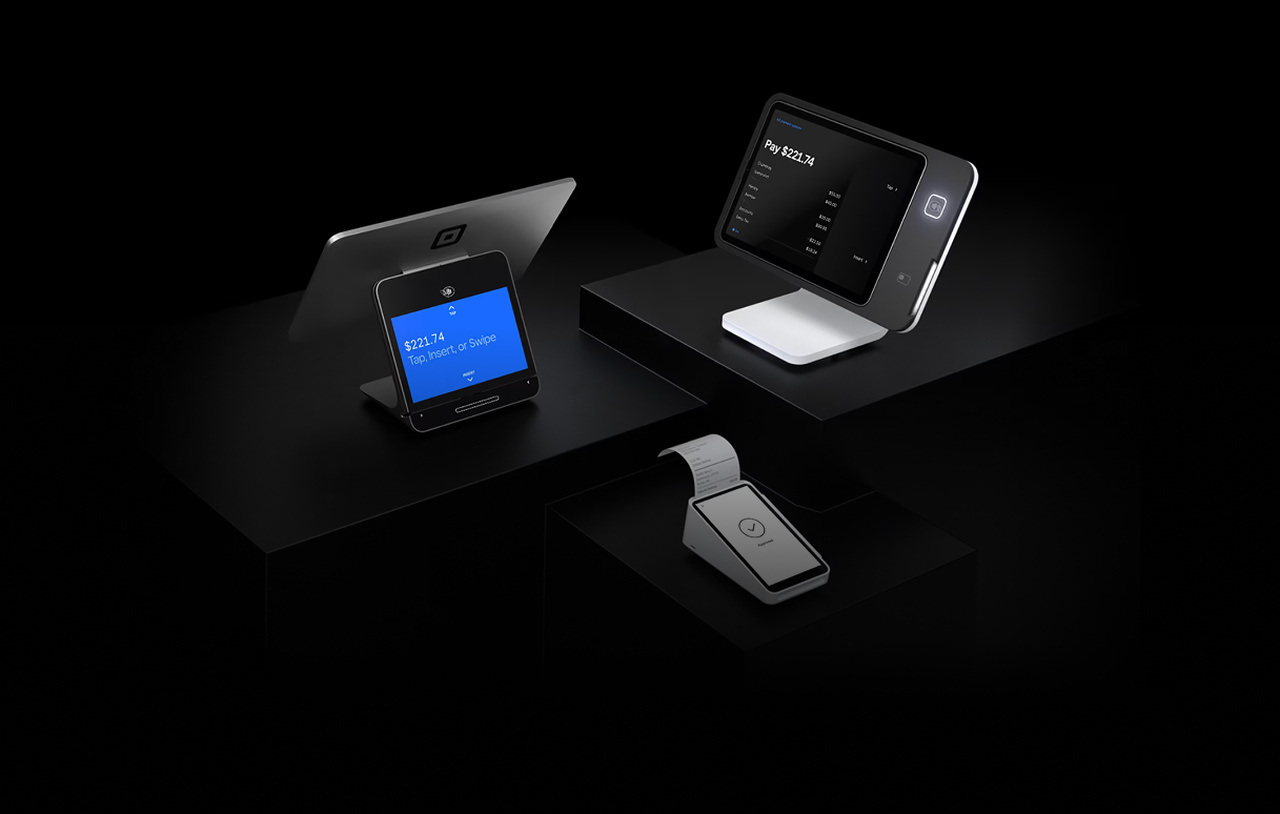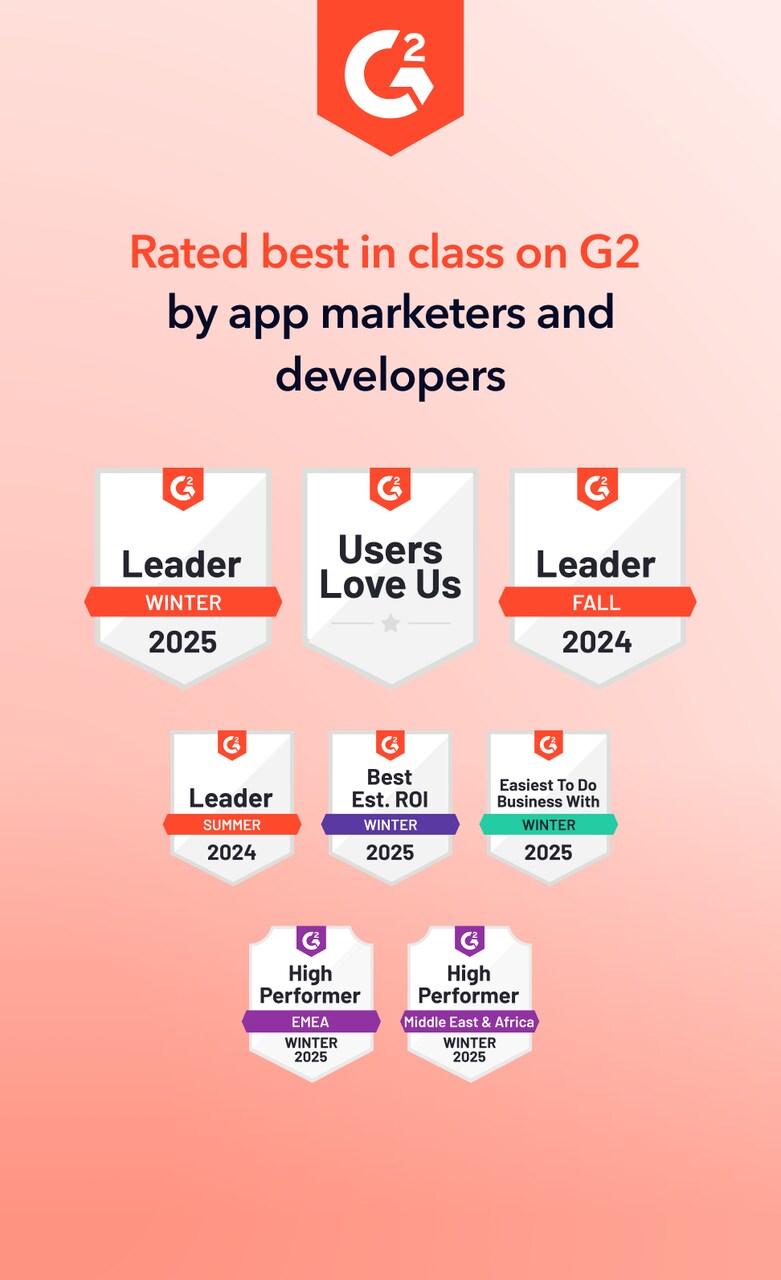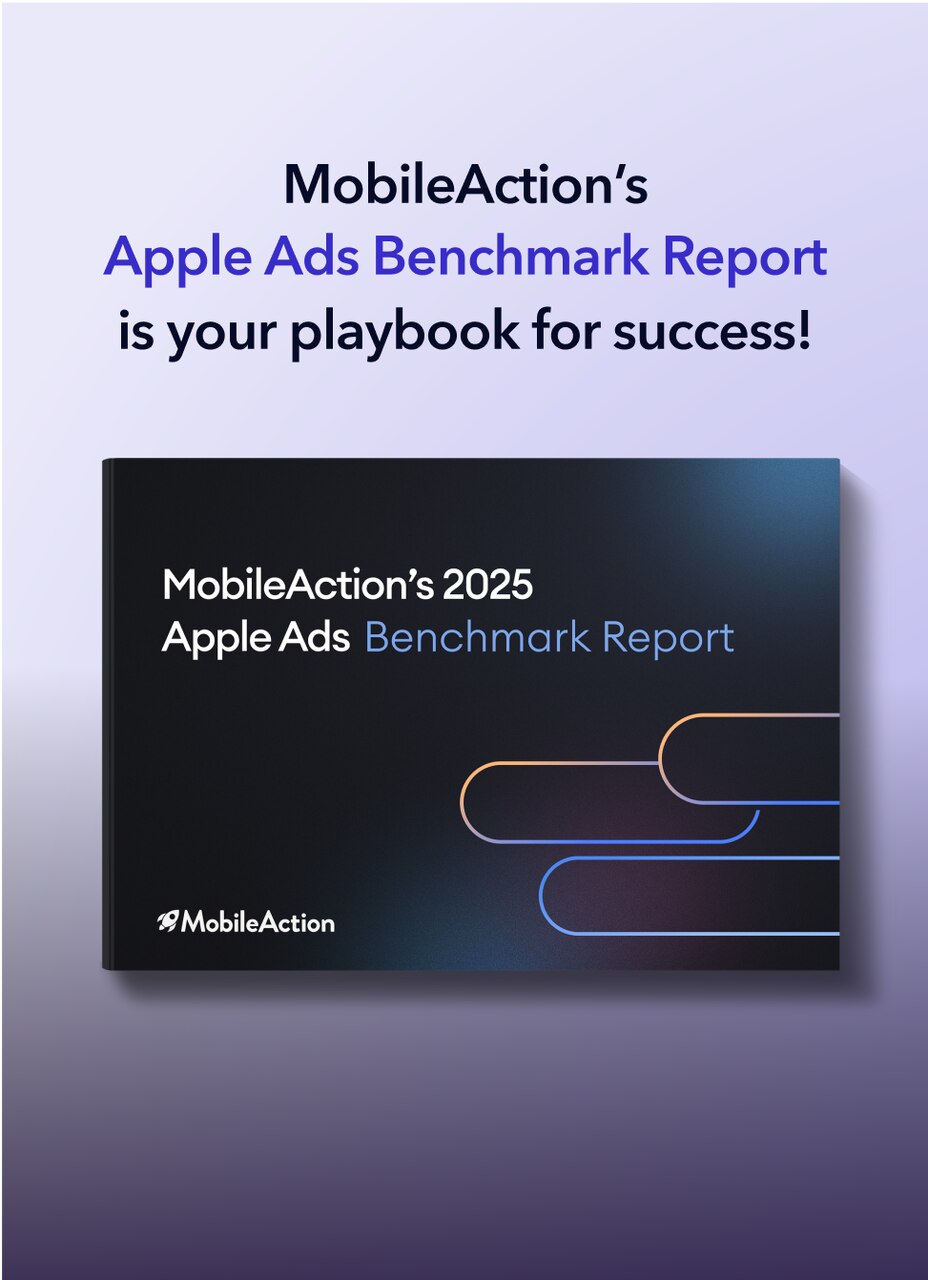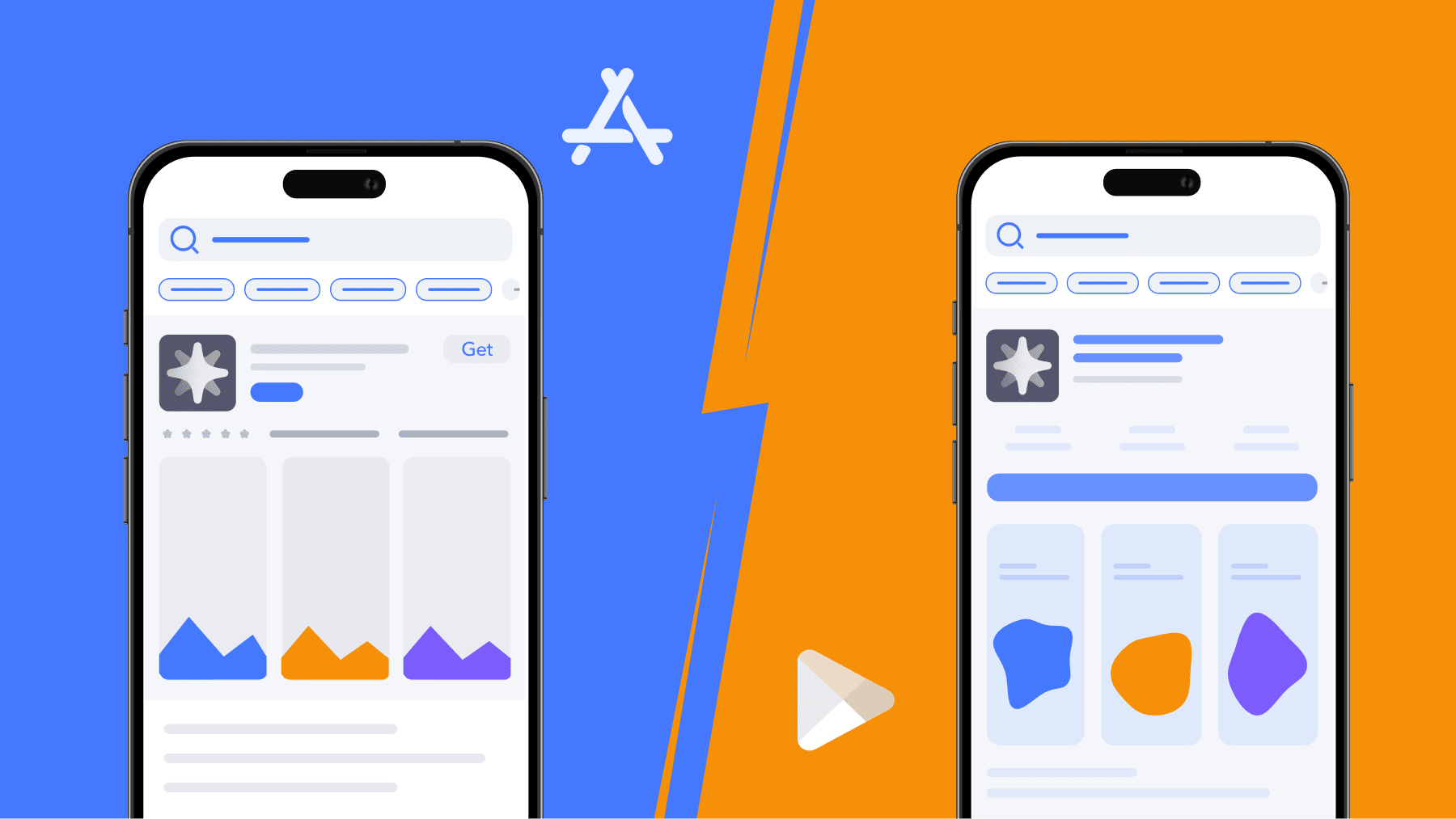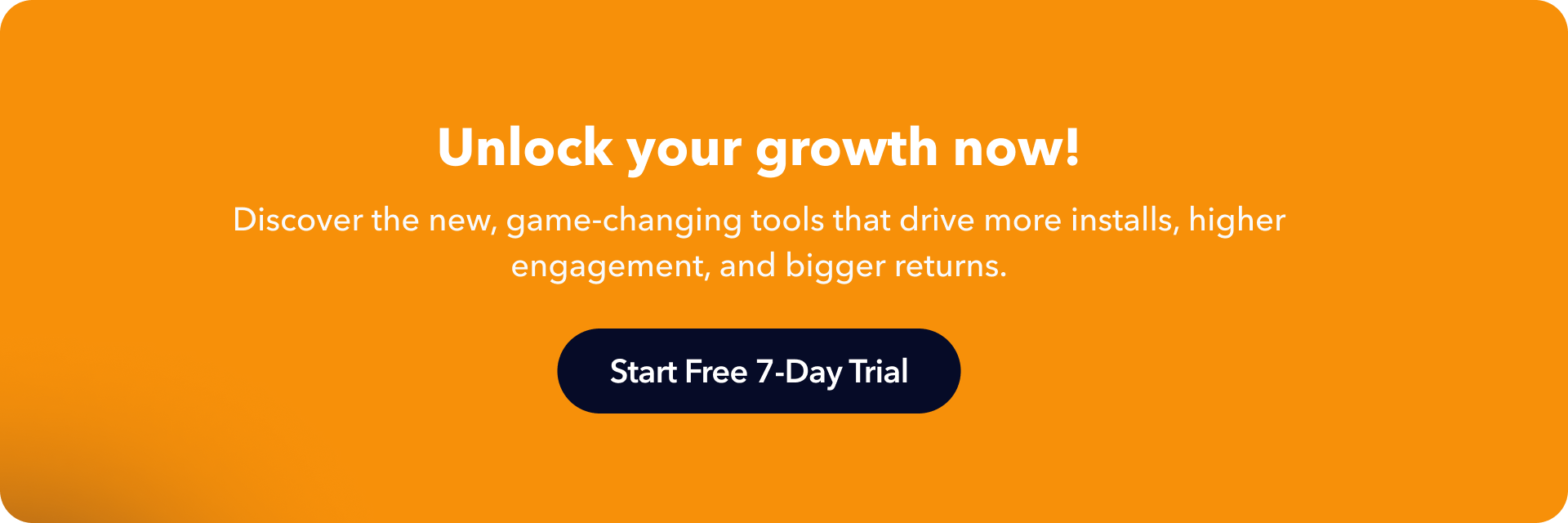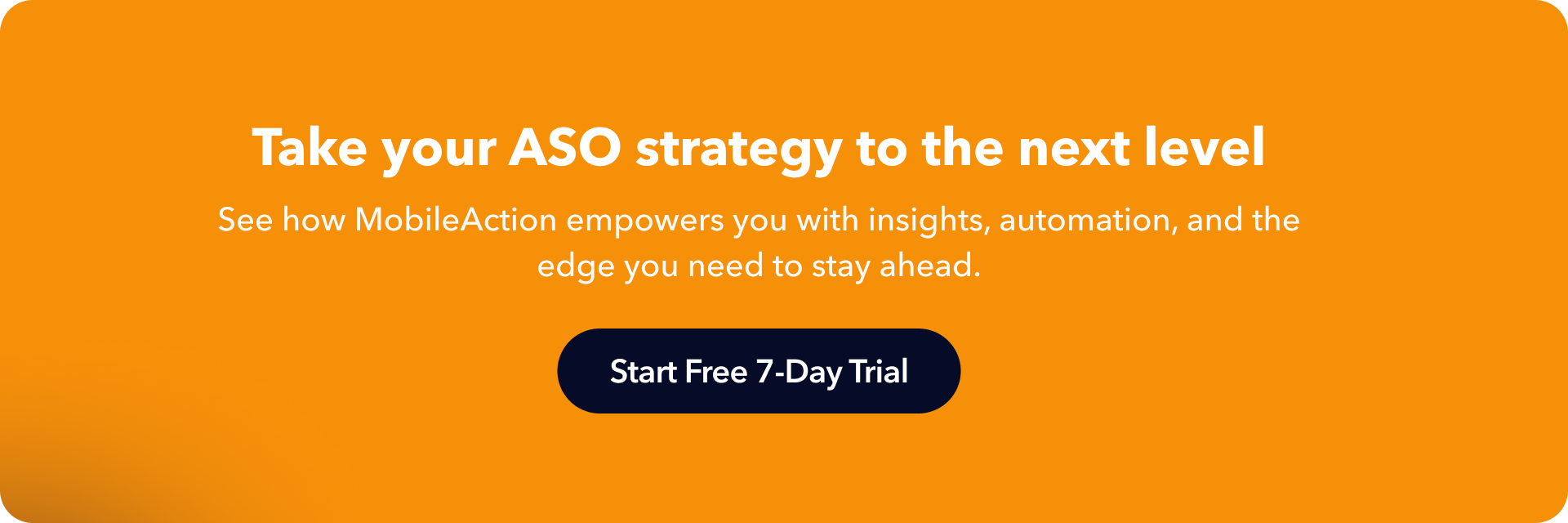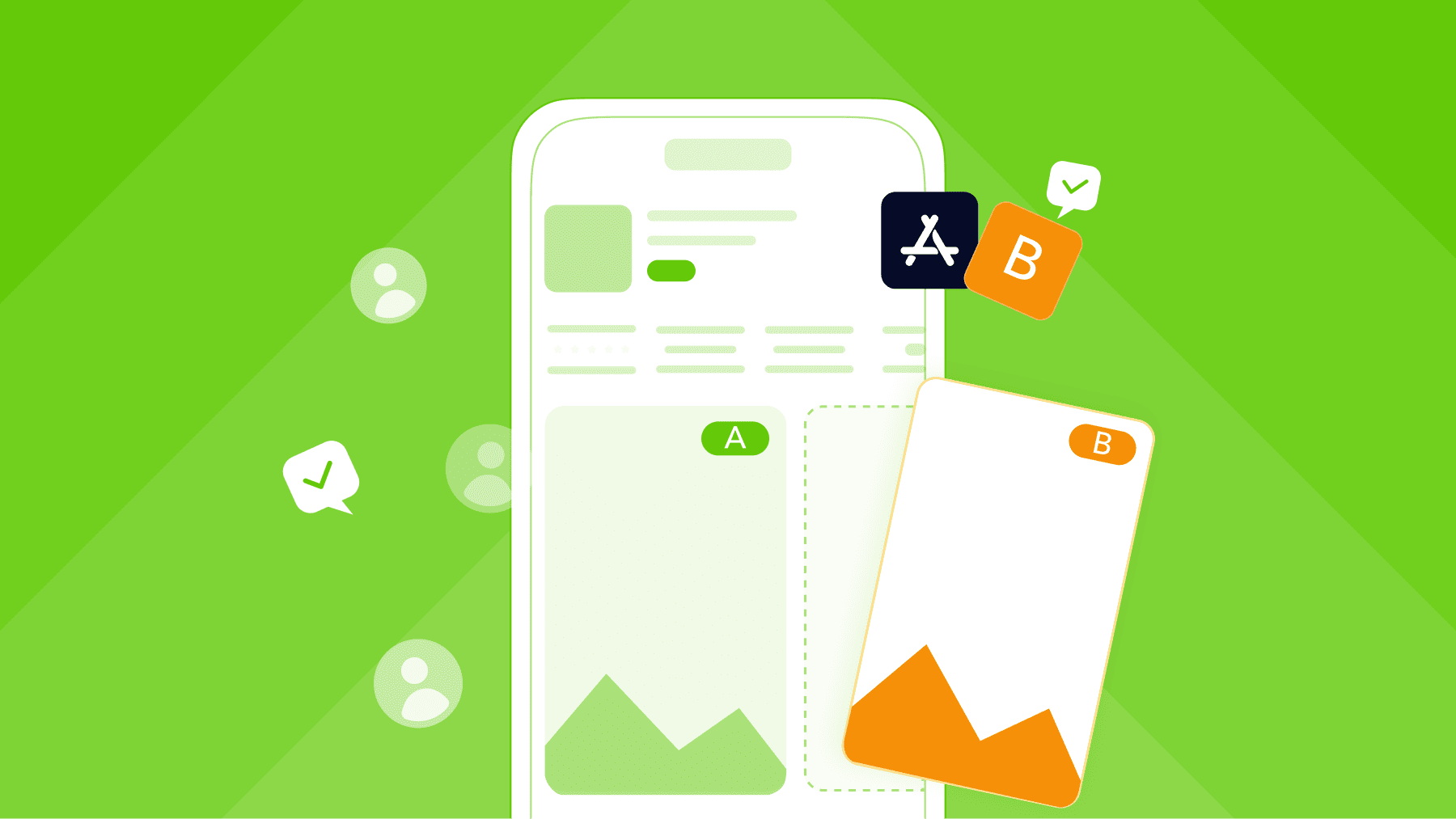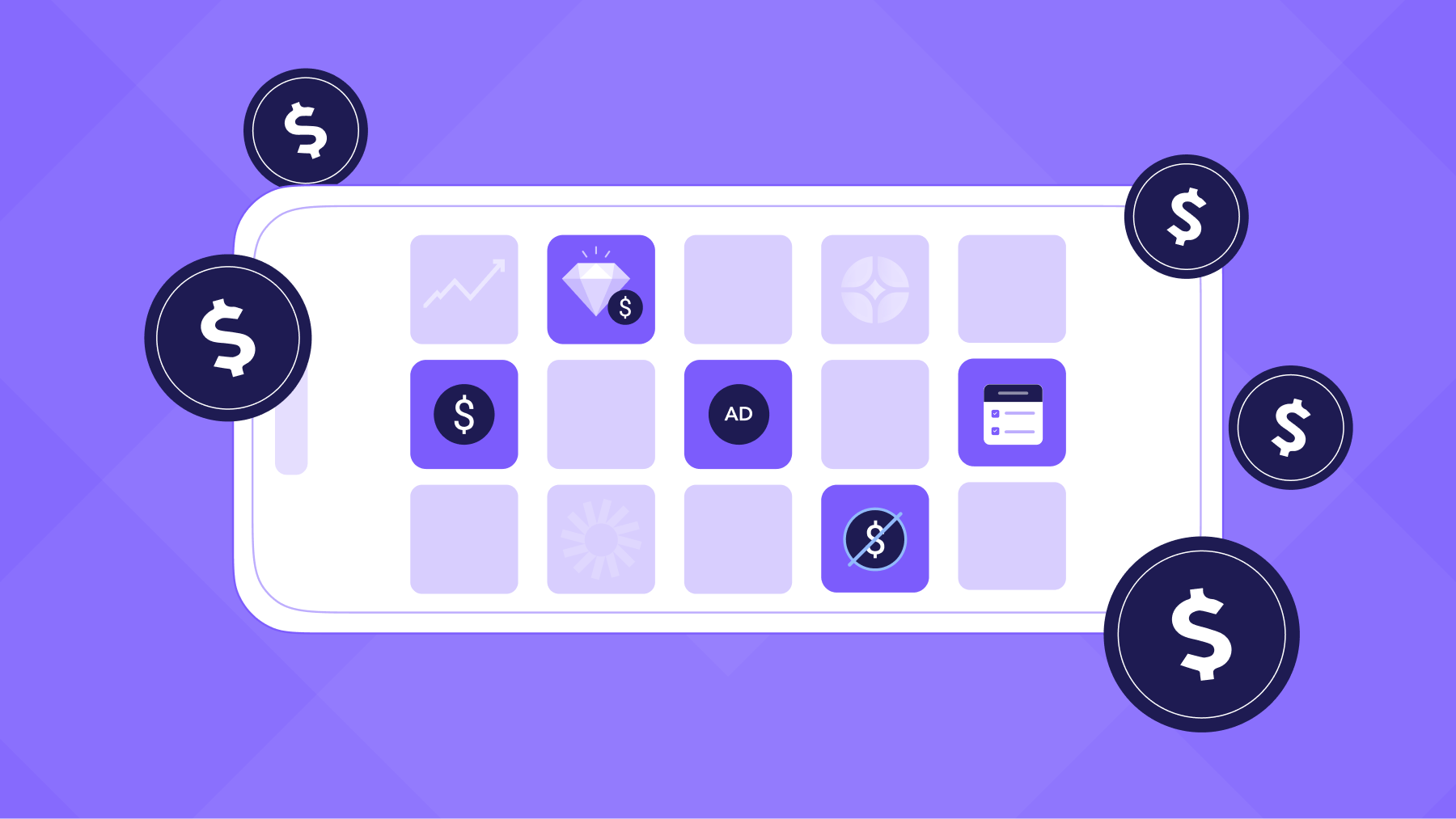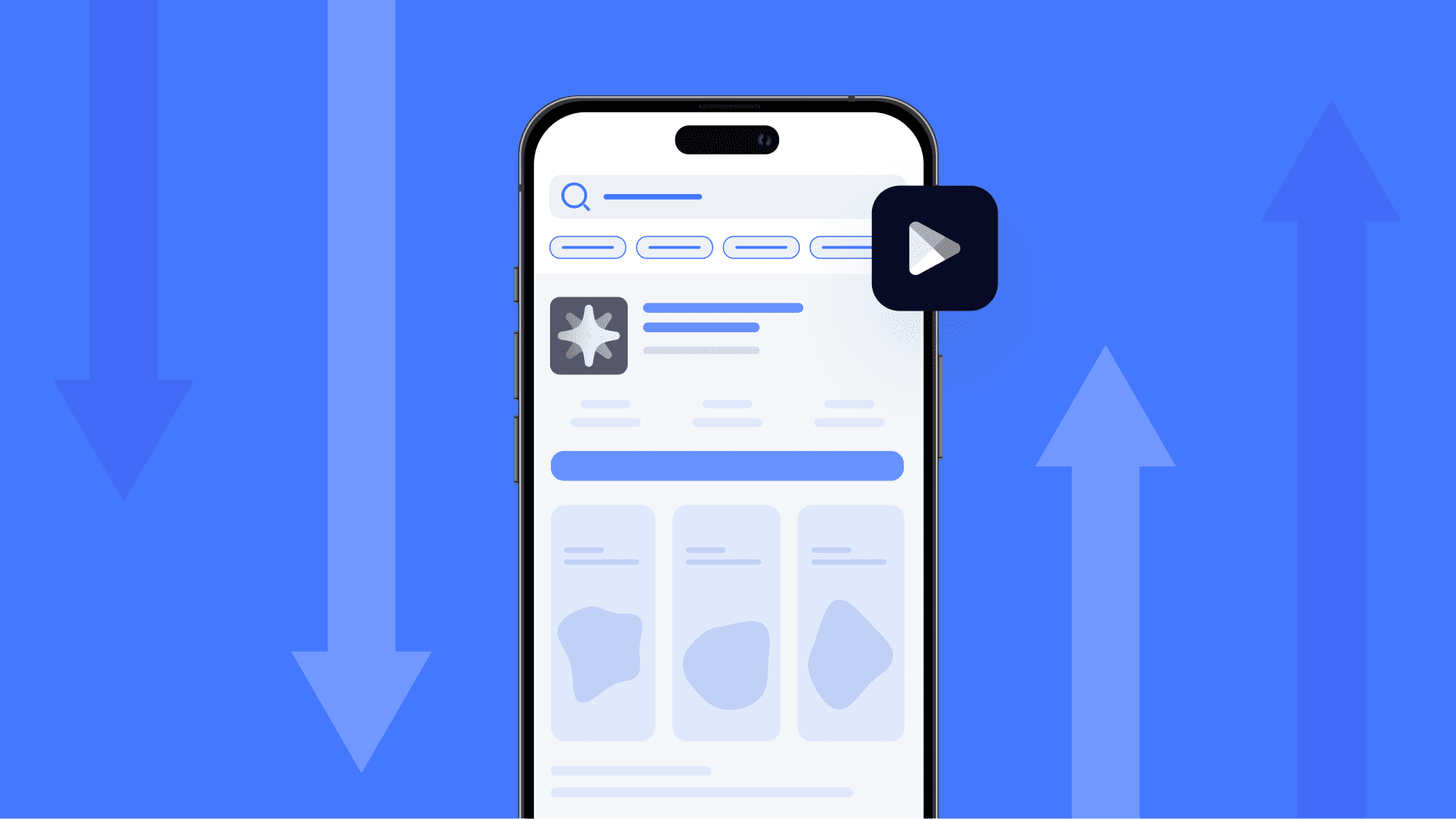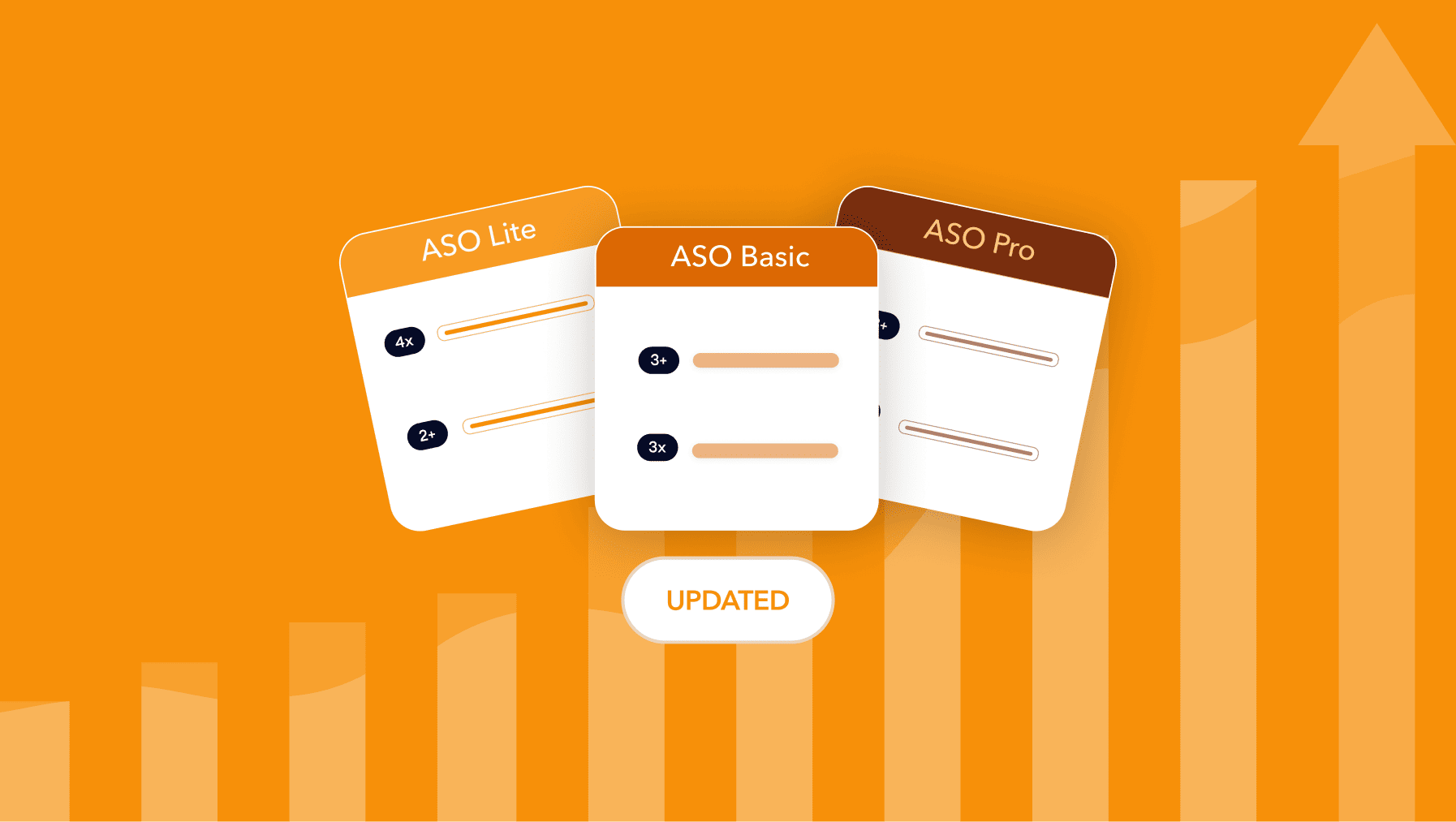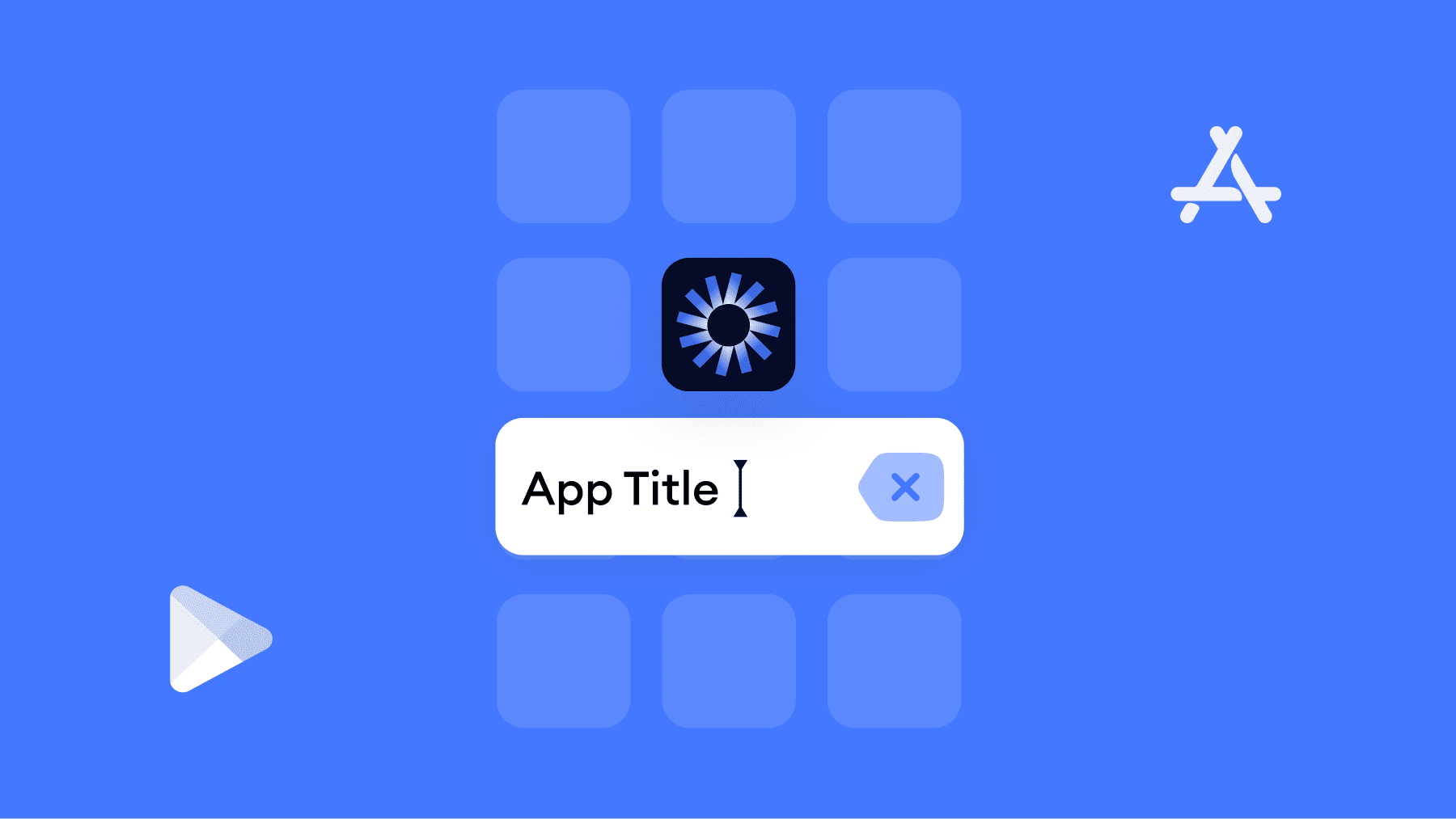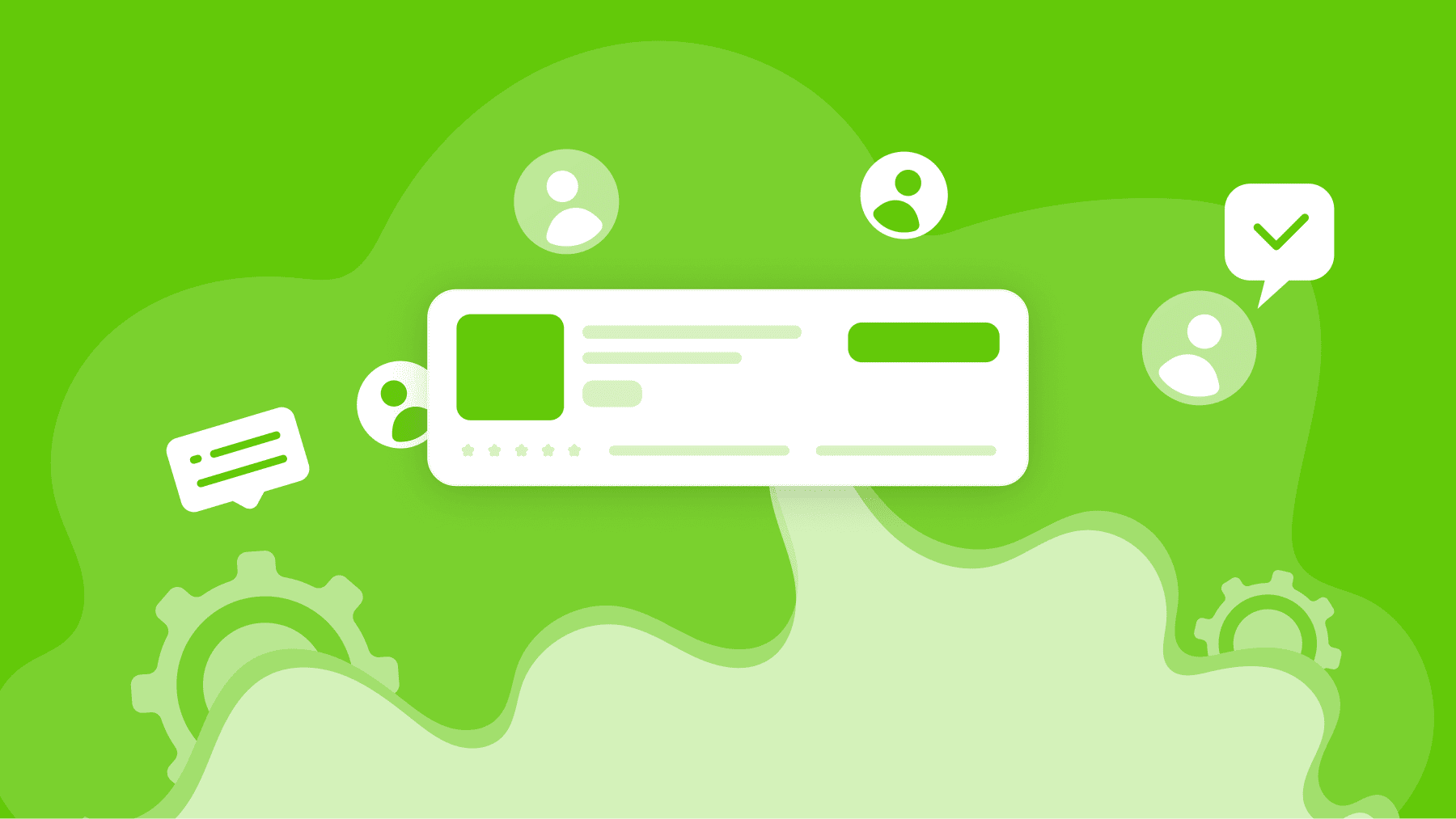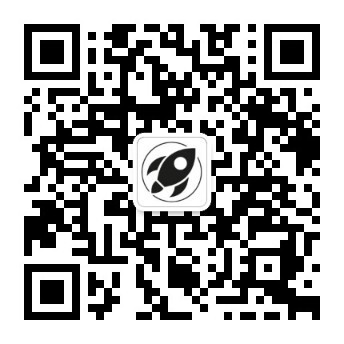Looking to boost your app's visibility and acquire more users? Our 2025 ASO Report is your ultimate guide to navigating the evolving app store landscape. Packed with data-driven insights, keyword trends, and top-ranking app strategies, this report will equip you with the knowledge to optimize your app's presence and achieve organic growth.
When you publish a mobile app, you have two primary distribution platforms: App Store and Google Play. While both serve the same purpose, the way they work is fundamentally different.
From app review systems to ASO capabilities, and from creative requirements to monetization rules, these differences directly impact your app’s visibility, conversion rate, and long-term growth.
In this post, we’ll break down the key differences between App Store & Play Store in 2025, focusing on areas that matter most for ASO and app marketing teams: how metadata works, what creative assets are supported, how app store listings can be customized, and how each store handles featuring, ads, and monetization.
Key Takeaways
- App Store uses a separate keyword field and strict character limits. Google Play relies more heavily on keyword density and long-form descriptions.
- Visual storytelling differs: app screenshots appear directly in App Store search, while Google Play emphasizes the full store listing page.
- Apple lets you create 70 custom product pages with unique URLs and deep links for both paid and organic traffic. Google lets you create 50 custom store listings, enabling deeper audience segmentation by country, user type, or traffic source.
- Promotional content formats, like in-app events (App Store) and promotional content (Google Play), offer different visibility mechanisms.
- Featuring opportunities are editorially curated in the App Store and algorithmic in Google Play.
- Paid ads differ: Apple Ads are keyword-driven, while Google App Campaigns automatically decides where and when your ads appear across its entire ad network.
- Monetization models and ARPU vary; iOS typically performs better in mature markets, and Android scales better in emerging regions.
App Store vs Google Play: Ecosystem differences
Privacy-first (Apple ATT) vs. data-rich (Google Ads + Firebase)
Privacy and data access are handled very differently on the App Store and Google Play, which is one of the main contrasts in the App Store vs Google Play experience.
Apple introduced App Tracking Transparency (ATT), requiring user opt-in for tracking across apps and websites. This limits the data available to advertisers and developers, especially for performance marketing and attribution.
Google continues to support richer user-level data through platforms like Firebase, Google Ads, and Play Console. While Google is also adopting privacy measures (e.g., Privacy Sandbox on Android), developers still have more access to behavioral insights compared to iOS.
Key considerations:
- On iOS, expect less precise user data and conversion tracking.
- On Android, you can still leverage deeper analytics and targeting (for now).
MobileAction’s ASO Intelligence can help bridge the gap here by showing keyword performance, localization coverage, and creative benchmarks, even when in-app behavioral data is limited on iOS.
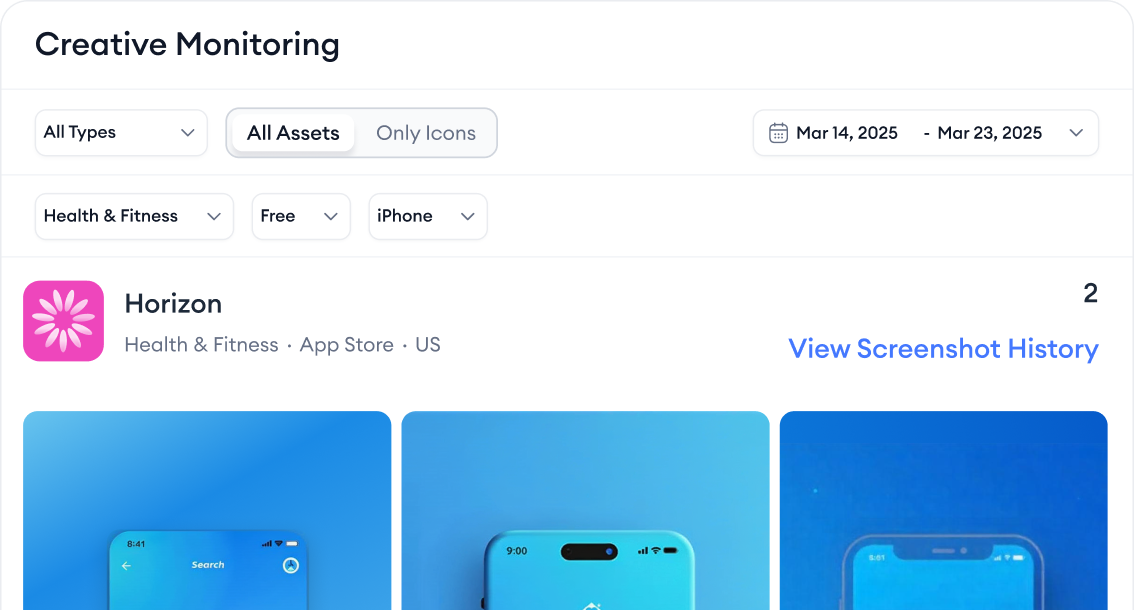
Manual review (App Store) vs automated review (Google Play)
One of the clearest differences in the App Store vs Google Play debate is how each platform handles app reviews.
Apple uses a manual app review process. Every app version and update is submitted for review by Apple through its review process before going live.
Google Play uses automated reviews by default, backed by machine learning. In most cases, apps go live within a few hours. Manual reviews are triggered only when automated systems detect potential issues or policy violations.
Implications:
- The App Store offers higher quality control but slower iteration.
- Google Play allows faster testing, but you may face rejections after publishing due to post-launch review.
Keyword indexing & metadata fields differences between App Store and Google Play
App Store: App name, subtitle, 100-character keyword field
Apple’s App Store uses a structured metadata system for keyword indexing:
- App name (30 characters max): Indexed heavily. Keywords here carry the most weight.
- Subtitle (30 characters max): Also indexed and highly visible in search results.
- Keyword field (100 characters total): Hidden from users but used for indexing. Comma-separated, no spaces needed.
Apple does not index the description for search rankings, unlike Google Play. This means you need to be strategic about how you use limited space across the Name, Subtitle, and Keyword Field.
Key rules:
- Avoid keyword repetition across fields; it doesn’t improve ranking.
- Word order matters: “language learning” ≠ “learning language.”
- Brand names and feature terms often compete for limited space, so prioritize high-intent search terms.
MobileAction’s Metadata Optimizer helps you test keyword combinations across these fields and predict which configurations will increase visibility without violating Apple’s guidelines.
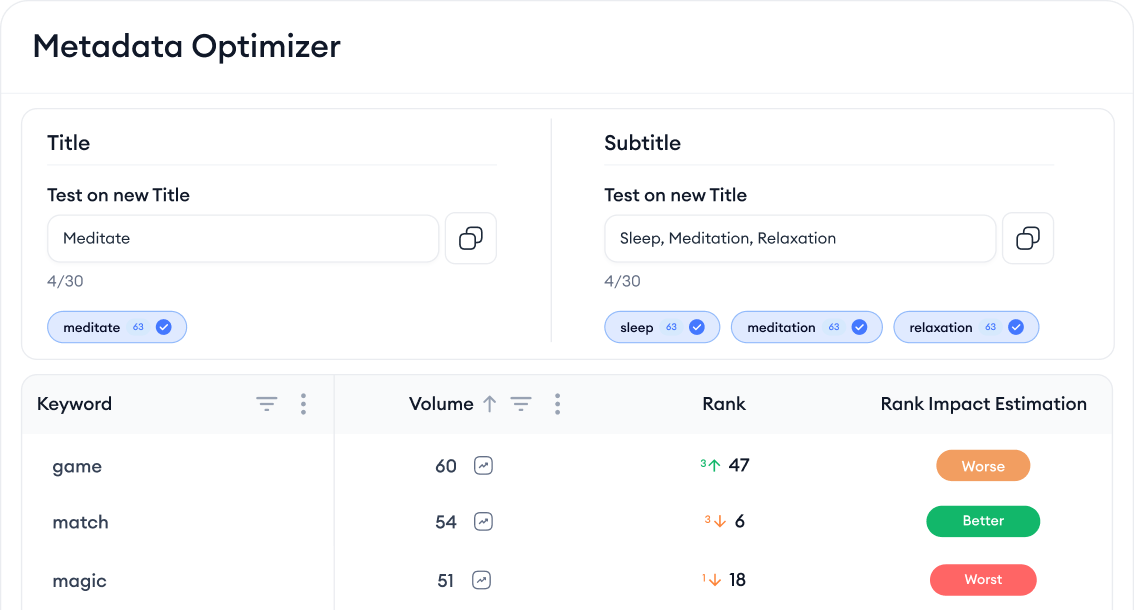
Google Play: Title, short description, long description
Google Play indexes more metadata fields and gives you more room to work with:
- Title (30 characters): Indexed and heavily weighted.
- Short Description (80 characters): Indexed and visible on the app page.
- Long Description (up to 4,000 characters): Fully indexed.
Unlike the App Store, keyword repetition is allowed and even recommended in moderation. Placing your main keywords multiple times throughout the long description can improve your chances of ranking.
Google also supports rich formatting (bold, bullet points) in the description to enhance readability, but excessive keyword stuffing or irrelevant content may trigger policy flags or ranking penalties.
Using MobileAction’s Keyword Tracking and Keyword Inspector, you can see how top-performing apps balance keyword density, readability, and compliance in their Google Play descriptions.
![]()
Keyword density vs. keyword precision
Apple prioritizes keyword precision; placing a keyword once in the correct field is enough. Overuse doesn’t help and may result in rejection for spam.
Google prioritizes keyword density; you’re rewarded for using high-volume keywords multiple times, naturally and strategically, in the description.
What this means for ASO teams:
- On the App Store, focus on placement and structure.
- On Google Play, focus on frequency and thematic consistency.
In both cases, MobileAction’s ASO Report can give you a comprehensive view of your indexed terms, keyword positions, and visibility gaps compared to competitors.
How each algorithm reads and ranks metadata
Apple’s search algorithm mainly looks at your App Name (Title), Subtitle, and the 100-character Keywords field when deciding which keywords your app should rank for. It also uses your app category choices to understand your app’s type.
Beyond text fields, Apple considers user behavior signals such as:
- How often people download your app
- How many users tap your store page and install
- Your app’s ratings and reviews
- App retention and app engagement (how often users return)
- Performance and stability (crashes, responsiveness, etc.)
While Apple doesn’t share its full ranking formula, ASO experts have noticed that In-App Events and even text in screenshots may also help your app appear in search results.
The App Store’s algorithm usually changes slowly, with bigger updates tied to new iOS releases or policy changes.
Google Play’s algorithm scans all the visible text on your store page:
- App Title
- Short Description
- Full (Long) Description
Unlike Apple, there’s no hidden keyword field. Instead, Google looks at how often and naturally keywords appear across these fields.
It also considers several behavior and quality signals, including:
- Installs (volume and growth rate)
- Conversion rate (visits → installs)
- Retention and engagement
- Uninstall rate
- Ratings and reviews
- App quality metrics such as Android Vitals (crash rate, load time, etc.)
Google updates its algorithm more frequently than Apple, so even small changes to your metadata can impact rankings quickly.
Screenshot & visual asset differences between App Store and Google Play
App Store: 10 screenshots, first 3 show in search
Apple allows up to 10 static screenshots per localization. These are displayed in order, and the first 3 screenshots are shown directly in App Store search results if no App Preview is present.

This makes the first three slots critical for your tap-through rate (TTR). You’re not just designing for the product page, you’re designing for the search listing (the card users see in search results) itself.
Other key points:
- Screenshots can be portrait (1242×2688) or landscape (2688×1242)
- You can include up to 3 App Preview videos, which autoplay muted
With MobileAction’s Creative Monitoring, you can track which screenshots top apps use in each country, how often they change visuals, and how your creative strategy compares.
Google Play: 8 screenshots, not shown in general search
Google Play supports up to 8 screenshots, but they do not appear in general search results; instead, they are only visible after a user clicks into the store listing page.

That means your screenshots support conversion, not visibility.
- Minimum of 2 screenshots required
- Recommended size: 1080×1920 (portrait) or 1920×1080 (landscape)
- Screenshots should show real in-app experience and follow Google’s visual policies
- You can also add 1 promo video (YouTube link only)
Unlike Apple, placement doesn’t affect ranking or visibility, but it heavily impacts user perception and install rates.
Ideal storytelling approach per store
Because Apple shows your screenshots in search results, focus on your main value right away. Your first 1–3 screenshots should quickly show:
- What the app does
- Why users should tap to learn more
- What makes it different from others
On Google Play, you have more room to build a narrative flow. The full screen is visible after a tap, so you can use screenshots to explain:
- Core features
- Use cases
- Social proof (awards, reviews, partnerships)
- Monetization model (free trial, premium, IAP)
Use MobileAction’s App Update Timeline to track when competitors update visuals and how often they test new storytelling formats.
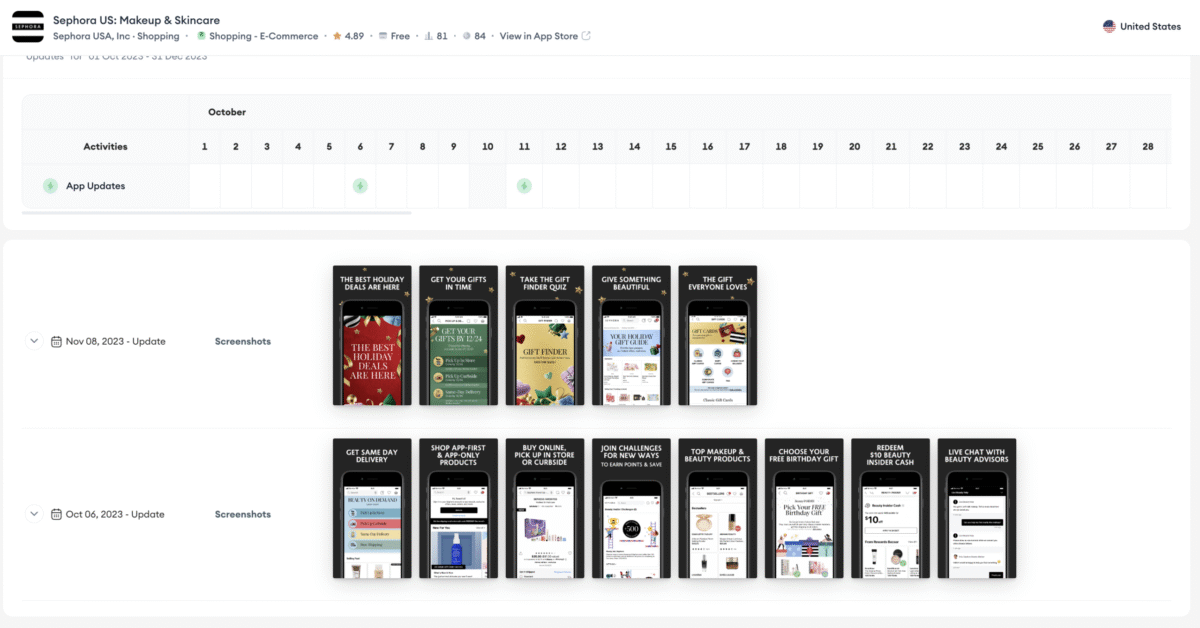
Localized vs. generic creatives, which matters more?
Localization improves conversion in both stores, but the impact is often greater on the App Store, where localized screenshots can affect both search and conversion.
- Apple lets you localize screenshots, App Previews, and metadata per country
- Google Play allows localization per language, which can span multiple countries
What this means:
- For example, if you’re targeting French speakers in both France and Canada, you’ll need 2 separate localizations on the App Store, but 1 language pack on Google Play
With MobileAction’s Localization, you can benchmark how top apps localize titles, subtitles, and screenshots across countries, helping you prioritize which regions to localize first.
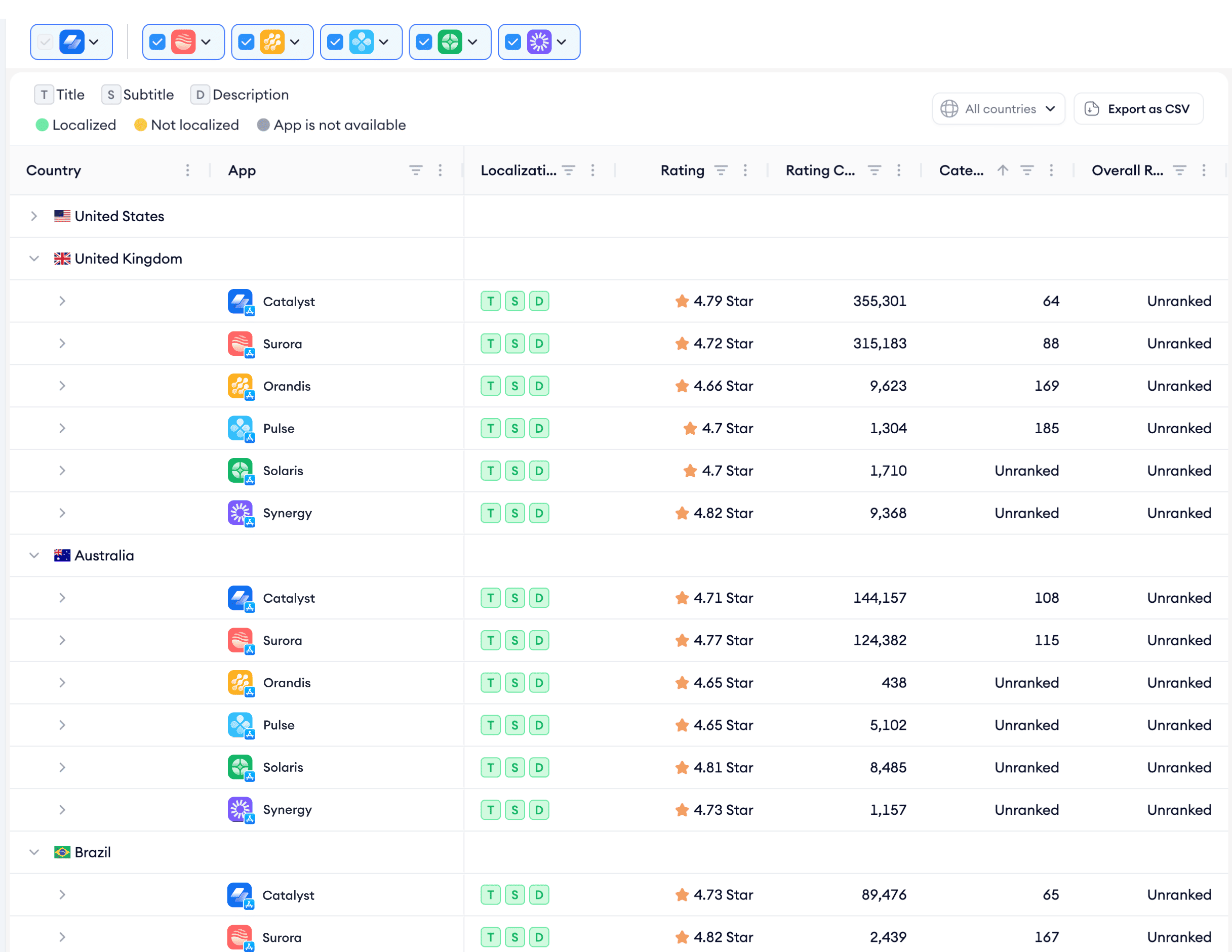
App preview vs. promo video: Video differences between App Store and Google Play
App Store: Max 3 preview videos, autoplay in search
The App Store lets you upload up to 3 App Preview videos per localization. These are short clips (15-30 seconds) that show actual app functionality. Key points:
- Autoplay in search: The first App Preview autoplays (muted) in App Store search results, giving you high visual exposure if no screenshots show up first.
- Must be recorded on Apple devices and follow Apple’s technical and content guidelines.
- Cannot be promotional, must reflect real in-app experience.
- Supports localization (language + visuals) per country.
These videos must be submitted with each app version update and go through Apple’s review process like other assets.
Best practices:
- Show the core feature or main value prop in the first 5 seconds.
- Keep pacing fast, avoid UI walkthroughs.
- Use on-screen text for clarity (especially with no audio).
You can monitor how top competitors use App Previews in each country using Creative Monitoring from MobileAction.
Google Play: 1 promo video (YouTube), appears on app listing page
Google Play supports 1 promo video, which appears at the top of your app listing page. Key distinctions:
- Must be hosted on YouTube and public or unlisted.
- Appears only on the app listing, not in search results.
- Can be promotional (unlike Apple). You’re allowed to use animation, voiceover, and music.
- Supports different language-specific URLs for localization.
This gives you more freedom in tone and storytelling, making it suitable for trailers, product overviews, or user testimonials.
Best practices:
- Hook users in the first 10 seconds.
- Add subtitles and calls to action.
- Highlight key benefits or differentiators.
Since it’s not limited to actual screen recordings, you can use this space more creatively than on iOS.
Format restrictions, tone, and conversion impact
| Store | Max Videos | Tone | Shown in Search? | Conversion Role |
| App Store | 3 | Strict, non-promotional | Yes | Boosts tap-through in search |
| Google Play | 1 (YouTube) | Promotional allowed | No | Supports conversion on the store page |
The App Store favors functional previews, while Google Play supports marketing-driven content. You should tailor your strategy accordingly; don’t reuse the same video for both.
Custom product pages (App Store) vs. custom store listings (Google Play)
Apple now allows you to create up to 70 custom product pages per app. Each custom product page is an alternate version of your App Store listing, featuring unique screenshots, app previews, and promotional text to highlight specific features or campaigns.
For example, in the screenshot below from MobileAction’s Organic CPP Results page, you can see Meditopia’s default product page and custom product page visuals side by side.
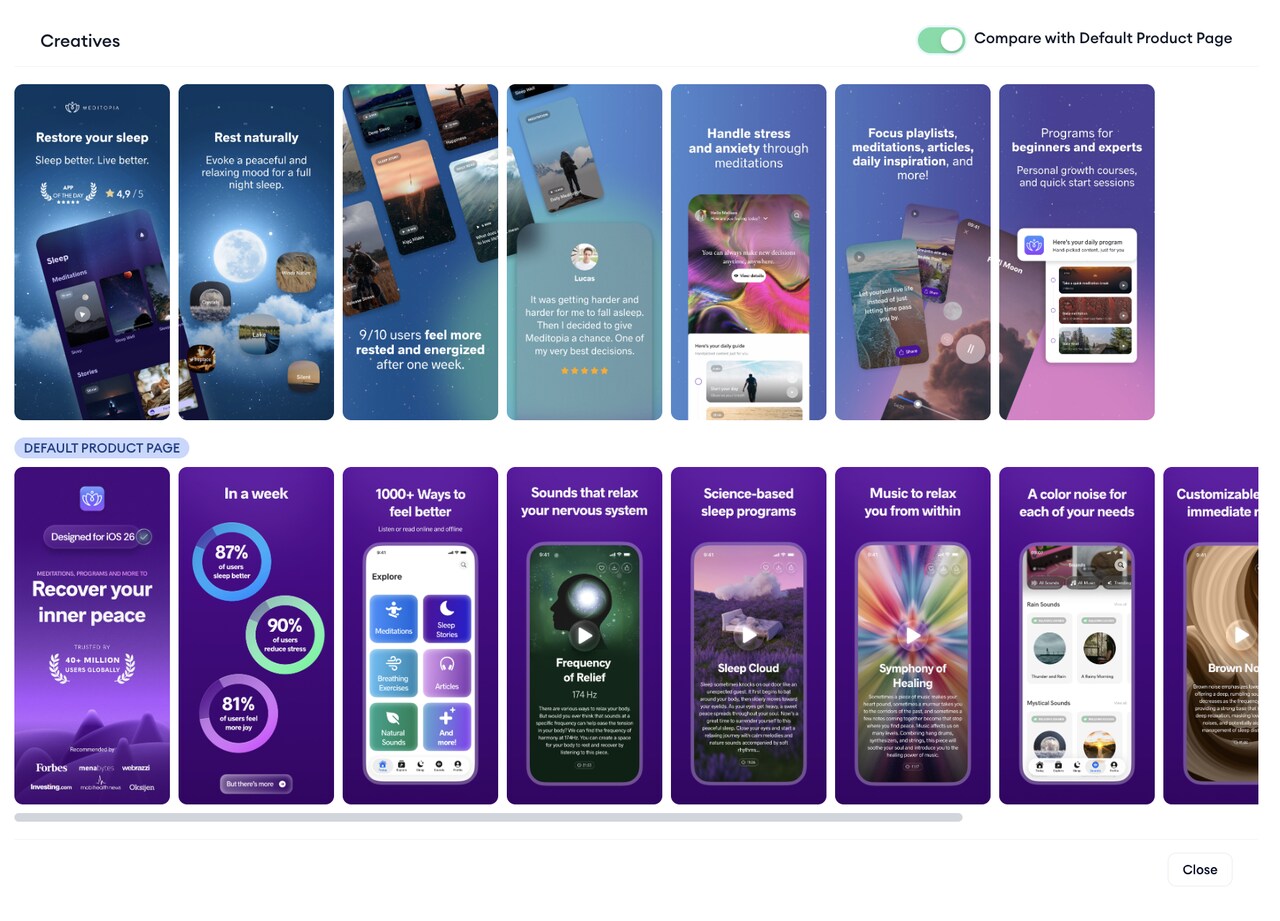
Each custom product page has a unique URL that you can use in ads, emails, or social campaigns. You can also attach a deep link, so users who install the app from that custom product page are directed to a specific screen or experience when they open the app.
Custom product pages can also appear in relevant App Store search results if you assign keywords to them. If no keywords are assigned, they remain discoverable only through their unique URLs, Apple Ads campaigns, or StoreKit-powered in-app promotions.
✴️ Pro tip: Developers using custom product pages see an average 2.5 percentage-point higher conversion rate compared to the default product page, according to Apple’s latest data.
With MobileAction’s CPP Intelligence, you can track your competitors’ custom product pages, see which variants they use for paid campaigns, and analyze creative performance across markets.
Google Play offers up to 50 custom store listings. These variants support different metadata and visuals for specific audiences based on country and install source.
Key benefits:
- Localize by region (e.g., India vs. Brazil)
- Match creatives to acquisition channel (e.g., Facebook vs. Google Ads)
- Automatically trigger the correct version using referral parameters
Audience targeting options
Audience targeting on the App Store works through Apple Ads. You can define who sees your ads by device type, country or region, user type (new, returning, or users of your other apps), and demographics like age and gender.
You can also connect each ad group to a custom product page, so users searching different keywords or interests see visuals and messages that fit their intent.
On Google Play, audience targeting happens inside custom store listings. You can create different versions of your listing for specific countries, keywords, install states (like re-engagement or pre-registration), or traffic sources such as campaigns or referral links.
This gives more control over how your app appears to different audiences across markets.
- Apple focuses on ad-level targeting through Apple Ads, then connects users to matching custom product pages.
- Google Play offers store-level targeting, letting you show tailored custom store listings by region, keyword, or traffic source.
Both let you adjust visuals, text, and language to make each version feel more relevant and localized for your audience.
You can use custom product pages and custom store listings to test:
- Keyword combinations
- Messaging strategies
- Value proposition formats
- Feature-led vs benefit-led creatives
MobileAction’s Conversion Funnel View and Organic CPP Results help you monitor performance by version and track how different creatives or metadata affect conversion and keyword visibility.
In-app events (App Store) vs. Promotional content (Google Play)
Both Apple and Google provide ways for developers to highlight time-sensitive updates and re-engage users, but their systems differ in flexibility, review process, and visibility. Understanding these differences helps you plan smarter in-app events & promotions across both platforms.
In-App Events are time-sensitive cards displayed in multiple parts of the App Store. Each event can highlight a promotion, update, or live feature.
Where they appear:
- In App Store search
- On your product page
- In the Today tab, Games, and Apps tabs
On the App Store, you can host up to 10 in-app events at a time, each lasting up to 31 days. Every event must be submitted with its metadata and media assets for Apple’s review before going live. This structured approach ensures quality and compliance, but means updates can’t be made instantly once approved.
Promotional Content allows developers to highlight seasonal or timely updates directly in the Play Store. Unlike Apple, Google gives developers more control over visibility triggers and creative style.
Placement:
- Store listing
- Highlights sections
- Themed promotional tabs
On Google Play, you can feature up to four live events simultaneously, but there are no duration limits. You can refresh or replace content at any time directly through the Play Console, and reviews are typically processed faster.
App Store vs Google Play featuring: Editorial picks vs algorithmic rankings
App Store: curated Today tab, apps & games stories
Apple’s App Store prioritizes editorial featuring. Apps are handpicked by Apple’s editorial team and showcased in places like:
- Today tab (hero banners and daily spotlights)
- Apps and Games tabs
- App of the Day and Game of the Day
- Featured collections (e.g., “Great on iPad,” “Made in Turkey”)
To be considered, your app must:
- Provide a high-quality, stable user experience with strong design and performance.
- Offer something unique, new technologies, a fresh approach, seasonal or culturally relevant content.
- Be well localised for multiple regions and languages.
Getting featured does not directly change your keyword rankings, but the increased exposure (downloads and visibility) can indirectly boost your App Store Optimization (ASO) performance.
Google Play: algorithmic featuring in charts and clusters
Google Play uses automated systems to determine featuring. Apps appear in:
- Top charts (downloads, trending, grossing)
- Suggested for you, Similar apps, and Cluster-based carousels
- Editorial sections (less prominent than App Store)
Google’s systems factor in:
- Download velocity
- Retention and engagement rates
- Crash rate and ANR (Application Not Responding) incidents
- Ratings and review volume
Because it’s algorithmic, high-performing apps can get featured without needing to pitch editors, but fluctuations are more common.
MobileAction’s Visibility Report helps track featuring exposure across countries, and the Download Report helps correlate spikes with feature placements.

Paid ads inside the stores: Apple Ads vs Google App Campaigns
Search tab ads, Today tab ads, product page ads (Apple Ads)
Apple Ads allows app marketers to show ads in these ad placements:
- Search results ads: Ads appear at the top of the results when users search for keywords.
- Search tab ads: Ads show at the top of the suggested apps list before users type a query.
- Today tab: Ads appear when users first launch the App Store, giving maximum visibility.
- Product pages ads – while browsing: Ads appear at the top of the “You Might Also Like” list inside product pages of other apps.
Key features:
- Full control over which ad placement you use, which creative assets appear, and which custom product page or deep link the tap leads to.
- You can link your ads to a custom product page with its own visuals, and use deep links for precise navigation inside the app (iOS 18+).
- Detailed reporting is available, including impressions, taps (CPT), installs, and conversions, though Apple’s privacy-first model limits exact post-install event tracking.
Apple’s privacy-first approach limits attribution, but ads can still boost app downloads when paired with strong metadata and visuals.
Keyword Targeting vs Automated Targeting (Google App Campaigns)
Google App Campaigns (formerly UAC) are fully automated campaigns that show across:
- Google Play search results
- Google Display Network
- YouTube
- Gmail and Discover
Key traits:
- No manual keyword input, Google chooses placements based on creative assets and goals
- Advertisers upload a mix of text, videos, and images
- Machine learning optimizes toward install or in-app action goals
This makes Google App Campaigns easier to manage but harder to control. Creative quality and volume are critical for success.
SearchAds.com by MobileAction platform helps you manage and optimize Apple Ads with keyword-level control and custom product page integration.
Monetization & revenue differences
Commission fees: 15%–30% rules on both platforms
Both stores follow a tiered commission model:
- 15% for subscriptions after the first year
- 15% for small developers (<$1M annual revenue)
- 30% default rate for most other in-app purchases and subscriptions
Google introduced its Play Media Experience Program, reducing fees further for specific media verticals (e.g., books, audio).
Both stores require you to use their in-app billing systems unless your app qualifies for exceptions (e.g., reader apps, certain regions like the EU).
ARPU trends: iOS higher in mature markets, Android scaling in emerging markets
Average Revenue Per User (ARPU) differs:
- iOS typically yields higher ARPU in North America, Europe, and Japan.
- Android performs better at scale in emerging markets like India, Brazil, and Southeast Asia.
This impacts monetization strategy:
- iOS is stronger for subscription-heavy and premium apps
- Android may drive more installs but often requires ad-supported or freemium models
You can benchmark ARPU trends using MobileAction’s Revenue Snapshot and Download Share by store and country.

Subscriptions vs IAPs, which model works better where?
- On the App Store, subscriptions dominate top-grossing charts, especially for health, productivity, and lifestyle categories.
- On Google Play, in-app purchases (IAPs) are still widely used in games and entertainment, though subscriptions are growing.
Both platforms support:
- Introductory offers
- Free trials
- Grace periods and billing retry logic
Use platform-native monetization where required, and align your pricing structure with local spending behavior.
Conclusion: Choosing Between App Store & Google Play in 2025
When comparing the App Store & Google Play, it’s clear that each platform has its own strengths, challenges, and rules. The App Store vs Google Play debate isn’t about which is better overall, it’s about which is better for your app, audience, and goals.
If you’re focused on premium markets, design quality, and higher lifetime value, the App Store might be your best first step. Its closed system ensures consistency and trust but limits flexibility. On the other hand, if you want faster iteration, easier testing, and access to broader audiences, the Google Play Store gives you more control and scale, though you’ll need to manage device fragmentation and stricter automated policies.
In short:
- The App Store offers a curated, high-value environment.
- The Google Play Store offers reach, flexibility, and speed.
The best app teams learn to master both. By understanding how App Store vs Play Store ecosystems work, from metadata rules to creative formats, you can design smarter ASO strategies, improve visibility, and drive higher conversion across every market.
No matter where you launch first, using unified insights from tools like MobileAction helps you make data-driven decisions across both stores, turning platform differences into a growth advantage.
Frequently asked questions
Which store should you launch first: App Store or Google Play?
It depends on who your users are and what kind of app you’re launching.
If most of your target users use iPhones, then launching on the App Store first makes more sense. But if you’re aiming for Android users, you should start with Google Play.
Some app teams launch on Google Play first because it’s easier to test and cheaper to get early users. It also supports more devices, which helps you find bugs and fix issues faster. Other teams choose to launch on both stores at the same time so their marketing stays consistent.
There’s no one right answer. Think about your budget, your team’s speed, and the countries you’re targeting. If you want fast testing and more flexibility, Google Play is a good first step. If you want higher-value users and tighter control, the App Store might be better.
Are the App Store and Google Play the same?
No. The App Store and Google Play aren’t the same, but they both let users discover and download mobile apps safely.
The App Store, owned by Apple, is used on iPhones and iPads. Apps go through a manual review before publishing, which ensures high quality but can slow down updates. Apple also has strict design and privacy guidelines, such as App Tracking Transparency (ATT), which limits how much user data apps can collect. Payments must usually go through Apple’s system, and descriptions don’t affect search ranking, instead, keyword fields do.
Google Play, owned by Google, is used on Android devices made by many brands. It relies on automated app reviews, so updates go live faster. Developers have more control over how they use keywords in titles and descriptions, and Google’s tools like Firebase and Google Ads give richer analytics and targeting options. Payments also go through Google Play Billing, but there’s more flexibility in some regions and categories.
What are the disadvantages of Google Play?
Google Play gives you freedom, but there are a few downsides you should know.
First, the app review process is not always clear. Most apps go live quickly because reviews are automated, but if your app gets flagged by the system, it can be delayed for days. You might not even know what caused the issue until you contact support.
Second, the store uses machine learning to check for policy violations. That means your app could be taken down automatically even if you didn’t break any rules. You have to go through an appeal process to fix it.
Third, Android devices vary a lot. Unlike Apple, which controls all its devices, Android runs on thousands of different phones. This means you have to test more, and your app might work well on one phone but have problems on another.


